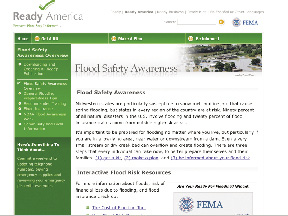March 14th through 18th 2011 marked Flood Awareness Week - and for good reason. Only one year ago, flooding on a scale rarely seen in New England forced people from their homes and businesses. Municipal sewage and storm water systems were overwhelmed and bridges and highways throughout New England were washed out. "As the nation's most common and expensive natural disaster, floods can strike virtually every community," said FEMA Administrator Craig Fugate, and flash flooding can take only a few minutes to a few hours to develop.
According to the National Weather Service, "Americans live in the most severe weather-prone country on Earth. Each year, Americans cope with an average of 10,000 thunderstorms, 5,000 floods, 1,000 tornadoes, and an average of 2 land-falling deadly hurricanes. And this on top of winter storms, intense summer heat, high winds, wild fires and other deadly weather impacts." The Northeast currently has an above-average flooding risk, including southern New England. Significant rains during October and November 2010 increased the moisture load in the soil, and several winter storms bought above average snowfall and river icing. The Greater Boston area received almost 90 inches of snow over the course of the 2010-2011 winter snow season. The possibility of heavy rains combined with snow melt could overwhelm rivers, streams and watersheds. Heavy rains are not limited to springtime. Fast-moving thunderstorms in July 2010 resulted in millions of dollars of damage and disruption to downtown properties where municipal systems could not drain the accumulated rainfall quickly, resulting in rapid street flooding.
Are you prepared?
Just a few inches of water from a flood can cause tens of thousands of dollars in damage. Over the past 10 years, the average flood claim has amounted to over $33,000. A flood between 6" and 1' in a 5000 square foot office area can cost over $100,000 to clean, restore or replace damaged spaces and contents. Add to this the cost of business interruption, loss of customers and disruption to workers' and occupants' livelihood. How are you preparing for possible flooding? Consider the following:
- Is your property in a flood plain or Special Flood Hazard Area (SFHA)?
- Has recent construction or development changed drainage characteristics?
- Are key business operations at risk for flooding?
- Do you have a recovery plan in place in the event flooding occurs?
A good recovery plan should include pre-arranged provisions for:
- paying the cost of recovery, either through flood insurance or a reserve fund
- communications with stakeholders and the public through the recovery process
- maintaining minimum business operations through the disaster recovery period
- strategic service partners capable of rapid response and stabilization services with pre-negotiated pricing and service expectations
FEMA and NOAA's National Weather Service are providing tips and information to help businesses, individuals and families prepare for flooding dangers during the week and throughout the spring season. The resources can be accessed at the Flood Safety Awareness Week landing page, located at www.ready.gov/floodawareness. If you are serious about continuity planning, you can join an association that specializes in disaster recovery planning or hire a contingency planning specialist or consultant. FEMA's Continuity Assistance Tool (CAT), a helpful starter plan, is available to private sector planners at http://www.ready.gov/business/
"Prepare. Plan. Stay informed."
Gerry McGonagle is the general manager BELFOR Property Restoration, Hopkinton, Mass.
Tags:
Flood awareness: visit ready.gov/floodawareness to help with your businesses continuity plan
March 24, 2011 - Spotlights










